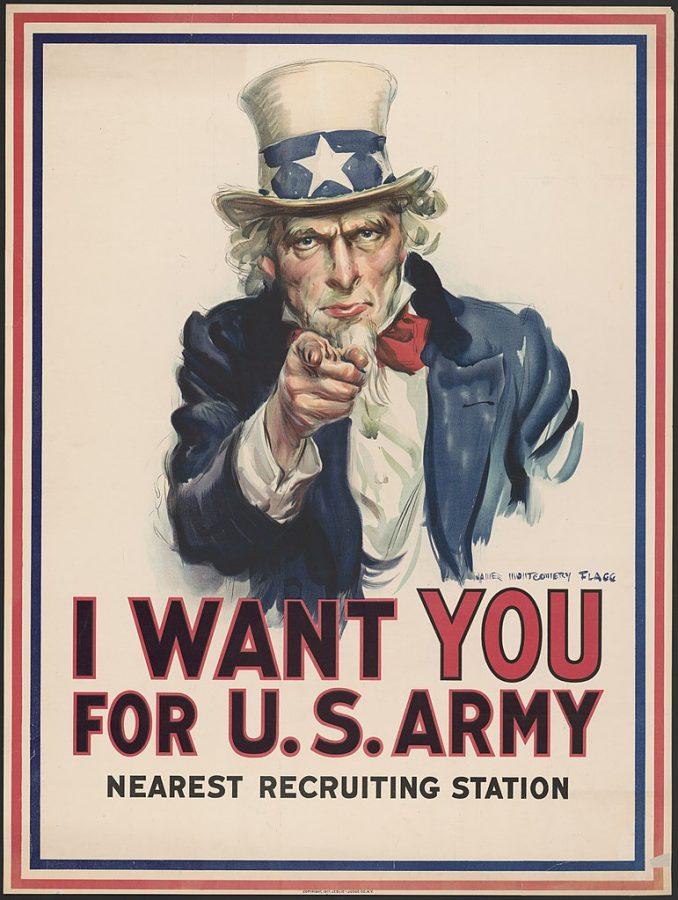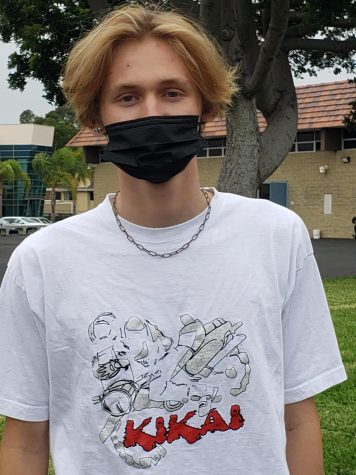Why Military Recruitment at High Schools Should be Outlawed
April 3, 2020
At the initial conception of the United States of America, teengagers were encouraged to join the American military and motivated to fight for their nation’s sovereignty. In the midst of the civil war, military service was made to be mandatory for young males, primarily ages 21-30, and since then, the U.S has lowered the minimum age of service to 18, allowing mere 18 year old males to be eligible for mandatory service, as males ages 18-25 are legally required to sign up for the draft.
The U.S military recruitment process is the system by which current or retired members of the military attempt to enlist more people into the armed forces. This process usually occurs in schools, youth organizations, over the internet, or even on television. However, the mechanism by which military recruiters attract most recruits is directly through recruitment in high schools. Notably, it’s not just “any high school” that draws military recruiters. Most recruitment takes place in low income schools, targeting specifically poverty stricken communities. This phenomenon is described by Teen Vogue’s Adryan Corcione in his article, The Military Targets Youth for Recruitment, Especially at Poor Schools, where he states,”The military markets to teenagers, particularly those in poorer school districts, because the armed services need a large population.” Showing that the military intentionally seeks out more vulnerable students who have a higher likelihood of joining the military due to their unfortunate financial situations. The structure and top level methodology of the U.S Military recruitment practices ought to be reformed to both: stop recruiting at schools, and end the isolation and coercion of low-income students in the inner-city.
We as Americans have become desensitized to the severity and consequence of war. Slow cultural genocide is a function of ongoing U.S colonial efforts and yet the media spends disproportionality more time on potential nuclear outbreaks with low probability. Walter Mignolo, a professor at Duke and author of The De-Colonial Option and the Meaning of Identity in Politics says, “the value of human lives to which the life of the enunciator belongs becomes the measuring stick to evaluate other human lives who do not have the intellectual option and institutional power to tell the story.” Mignolo’s description of “the enunciator ” refers to the job of the modern media to report on international conflicts, as they are supposed to be voicing issues. This analysis of the media’s value system shows media affectation has the ability to evaluate the validity of certain violence and we thus presume that any violence not legitimized by the media, like ongoing violence in Okinawa, has presumably less value than one percent probability of nuclear conflicts in Ukraine. A simple google search of “violence in Okinawa” brings up a few dated articles regarding the infamous rape incident between U.S Military soldiers were exempted from consequence despite having plead guilty to the rape of a Japanese civilian, regardless of the countless incidents of U.S military soldiers committing violent war crimes against citizens. For instance, Yoshiko Shimabukuro, who witnessed the violence imposed by military soldiers onto the Okinawinian population, describing the mutilation of an insurgent: “They had legs ripped off, their intestines were falling out, faces missing. We simply had no idea what to do. I was 17. We all thought we would be back at school in a week.”
Racial minorities who join the military in attempt to solve their financial situations often fail to reap the promised benefits of service, and find themselves in an even worse situation. Over one of every ten American homeless males are military vets, and tend to have fought in the military directly after high school. (US Inter-agency Council). This statistic shows the military doesn’t always ensure a stable path to financial success, and may potentially have drastic consequences on mental health. This is one example of the disappointing empirics that drive me to characterize the recruitment tactics as “coercive”, as the military is often advertised as a sure path to financial stability.
Many military practices are particularly harmful to young adults, especially non-white young adults. Mainly, the endeavor to homogenize all members of the military to a succinct unit, or a singular body. The homogenization tactic is used by the military to keep all constituents of a given force synchronized, to maximize efficiency and display a message of American sovereignty. This practice rips many of their individuality and prevents people from removing themselves from the battlefield, often being implicated as the main reason for post-traumatic stress-disorder. Homogenizing young adults at such an age poses a problem to the psychological development of a 20 year-old’s developing mind, as it confines them to the archetype of the “military man”. The military man archetype may be harmful to someone who joined the military to get out of a situation, as opposed to consuming all aspects of their identity. According to the U.S. Government Accountability Office, over two million veterans received mental health treatment from 2006 through 2010, and some of the main barriers veterans face, identified by the USGAO and other sources, include; personal embarrassment about service-related mental disabilities, shame over needing to seek mental health treatment and fear of being seen as weak. These problems can logically be attributed to the homogenization process, and the “military man” archetype that pushes men to be more manly, which often results in a suppression of emotions, and embarrassment of mental illness. Although homogenization can be harmful, numerous veterans attribute their discipline, brotherhood, and life-long friendships to the military’s attempt of creating a singular, comprehensive unit.
Creating a conducive environment to lure high-schoolers into U.S colonial efforts is an independent reason to outlaw recruiting in high schools. Recruiters have infiltrated academic settings and planted the seeds of nationalism into the vulnerable minds of literal children. Schools have worked in accordance with the U.S military to implement a program called JROTC or “junior reserve officer in training corps”, that works to teach students skills of military praxis. The incentive and benefit for joining such an activity is advertised by schools as “graduation preparation”. Marion City Schools, in Ohio says “JROTC Prepares Students for Graduation: Lt. Col. John Espinosa’s goal is to prepare students with the necessary skills to graduate.” This statement fundamentally misunderstands the goal of the JROTC program, as it’s essentially used as a tool to recruit young people into the military by instilling them with common military values. Painting the program as a necessary prerequisite to graduation assumes academic value is to be gained by the program, when in reality it focuses on scholarship mutually exclusive from the classroom.
Recruitment at high schools is an isolated instance where the government is fundamentally perverting the socio-economic status of certain individuals to insert them into colonialist schemes. Preying on the vulnerable at high schools is not the only mechanism military recruits have at their disposal, it only furthers a flawed process of recruitment.





